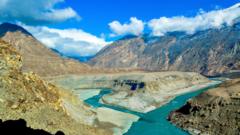The suspension of the Indus Waters Treaty by India raises questions about its potential to control river flows to Pakistan, sparking concerns over agricultural and hydropower impacts.**
India’s Water Control Dilemma: Implications of the Indus Waters Treaty Suspension**

India’s Water Control Dilemma: Implications of the Indus Waters Treaty Suspension**
Tensions rise as India contemplates halting river flows to Pakistan amid escalating conflicts.**
The recent suspension of the Indus Waters Treaty (IWT) by India has fueled intense speculation about whether the country can effectively halt the flow of the Indus River and its tributaries into Pakistan. This decision, made in response to a violent incident in Indian-administered Kashmir, has stirred concerns over water-sharing arrangements between the two nations, known for their fraught relations.
The IWT, established in 1960, has withstood numerous conflicts, including two wars. It regulates water sharing among six rivers in the Indus basin, with India allocated the eastern rivers—Ravi, Beas, and Sutlej—while Pakistan oversees the western rivers—Indus, Jhelum, and Chenab. The treaty has been a cornerstone of trans-boundary water management, but recent developments have caused India to review its obligations.
India accuses Pakistan of supporting terrorism, a claim that Islamabad vehemently denies. Following heightened tensions, India’s decision to suspend the treaty is seen as part of a broader retaliatory strategy. Pakistan has warned that any effort to stop river flow would be regarded as an act of war.
Experts caution that halting or diverting the Indus River’s waters is practically unfeasible for India, especially during periods of high flow. Current Indian water infrastructure, primarily run-of-the-river hydropower plants, lacks the capacity to store and redirect significant water volumes. This infrastructure has hampered India's ability to fully utilize its share of the rivers, prompting calls for new storage facilities, though Pakistan opposes such developments citing treaty concerns.
Challenges persist, including difficult geographical conditions and domestic protests that delay the construction of necessary water infrastructure. Reports suggest that despite intentions to expedite dam construction following previous militant attacks, progress remains sluggish. Should India manage to exert control over river flows, it could present substantial challenges for Pakistan, particularly during the dry season when water scarcity is more acute.
The IWT mandates the exchange of hydrological data between India and Pakistan, crucial for flood forecasting and agricultural planning. However, India has already been sharing limited data, exacerbating concerns regarding water management transparency. The region, vulnerable to monsoon-related flooding, is further complicated by India’s potential strategy of "weaponizing" water—managing river flows to cause downstream damage, though experts caution that such actions could backfire on Indian territory.
Additionally, the situation is interconnected with broader regional dynamics, particularly with China, which exercises control over the Brahmaputra River upstream from India. As India navigates its water policy amidst these tensions, implications for both agricultural stability and broader geopolitical relations remain profound and complex.





















